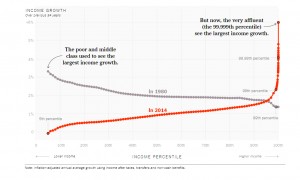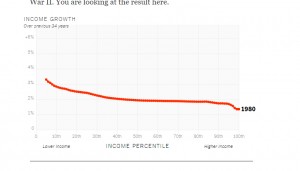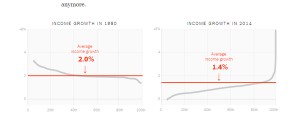- California Assembly OKs highest minimum wage in nation
- S. Korea unveils first graphic cigarette warnings
- US joins with South Korea, Japan in bid to deter North Korea
- LPGA golfer Chun In-gee finally back in action
- S. Korea won’t be top seed in final World Cup qualification round
- US men’s soccer misses 2nd straight Olympics
- US back on track in qualifying with 4-0 win over Guatemala
- High-intensity workout injuries spawn cottage industry
- CDC expands range of Zika mosquitoes into parts of Northeast
- Who knew? ‘The Walking Dead’ is helping families connect
Our Broken Economy, in One Simple Chart
https://www.nytimes.com/interactive/2017/08/07/opinion/leonhardt-income-inequality.html
Many Americans can’t remember anything other than an economy with skyrocketing inequality, in which living standards for most Americans are stagnating and the rich are pulling away. It feels inevitable.
But it’s not.
A well-known team of inequality researchers — Thomas Piketty, Emmanuel Saez and Gabriel Zucman — has been getting some attention recently for a chart it produced. It shows the change in income between 1980 and 2014 for every point on the distribution, and it neatly summarizes the recent soaring of inequality.
The line on the chart (which we have recreated as the red line above) resembles a classic hockey-stick graph. It’s mostly flat and close to zero, before spiking upward at the end. That spike shows that the very affluent, and only the very affluent, have received significant raises in recent decades.
This line captures the rise in inequality better than any other chart or simple summary that I’ve seen. So I went to the economists with a request: Could they produce versions of their chart for years before 1980, to capture the income trends following World War II. You are looking at the result here.
The message is straightforward. Only a few decades ago, the middle class and the poor weren’t just receiving healthy raises. Their take-home pay was rising even more rapidly, in percentage terms, than the pay of the rich.
The post-inflation, after-tax raises that were typical for the middle class during the pre-1980 period — about 2 percent a year — translate into rapid gains in living standards. At that rate, a household’s income almost doubles every 34 years. (The economists used 34-year windows to stay consistent with their original chart, which covered 1980 through 2014.)
In recent decades, by contrast, only very affluent families — those in roughly the top 1/40th of the income distribution — have received such large raises. Yes, the upper-middle class has done better than the middle class or the poor, but the huge gaps are between the super-rich and everyone else.
The basic problem is that most families used to receive something approaching their fair share of economic growth, and they don’t anymore.
It’s true that the country can’t magically return to the 1950s and 1960s (nor would we want to, all things considered). Economic growth was faster in those decades than we can reasonably expect today. Yet there is nothing natural about the distribution of today’s growth — the fact that our economic bounty flows overwhelmingly to a small share of the population.
Different policies could produce a different outcome. My list would start with a tax code that does less to favor the affluent, a better-functioning education system, more bargaining power for workers and less tolerance for corporate consolidation.
Remarkably, President Trump and the Republican leaders in Congress are trying to go in the other direction. They spent months trying to take away health insurance from millions of middle-class and poor families. Their initial tax-reform planswould reduce taxes for the rich much more than for everyone else. And they want to cut spending on schools, even though education is the single best way to improve middle-class living standards over the long term.
Most Americans would look at these charts and conclude that inequality is out of control. The president, on the other hand, seems to think that inequality isn’t big enough.



















Obat sipilis
August 11, 2017 at 9:55 PM
It should be like that, I totally agree with this article. Hope it always updates so I can add my insight
mobdro app alternatives
August 14, 2017 at 2:00 AM
Mobdro app user and Mobdro App Not Working on your Kodi, Android TV, Chromecast? this tutorial will help you Fix Mobdro not working Problem
Khasiat Walatra Sehat Mata Softgel
August 24, 2017 at 6:50 AM
nice post
obat mata minus
September 7, 2017 at 2:04 AM
sugoii
amey
September 9, 2017 at 1:58 PM
Currently, in this busy globe, our computers as nicely as the World Broad Web offer everyone a period for fun.
Cara Pemesanan Gamat Emas Kapsul
September 13, 2017 at 1:46 AM
rasakan beragam khasiat hanya dengan 1 obat